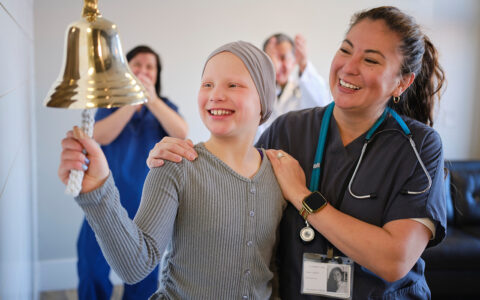From as early as the 1920s, support of hormone therapy for women has swung like a pendulum.
The benefits of supplemental estrogen during menopause were touted early on, then later eclipsed by concerns over cardiovascular side effects and cancer risks, followed by yet more contradictory studies.
In February, 2023, Kathryn Lindley, M.D., the Samuel S. Riven Director of the Women’s Heart Center at Vanderbilt University Medical Center, served as senior author on a literature review published in Circulation for the American College of Cardiology Cardiovascular Disease in Women Committee. The panel revisited the studies and parsed findings to provide insight into ways of improving treatment.
Among the findings was a tendency by the medical community to confer certain risks equally among all women that would more accurately be applied to only a segment of the patient cohort.
“There seems to be a tendency to generalize on risks that apply to just some women,” Lindley said. “But we know that by considering timing, delivery, dosage and comorbidities, we can mitigate risk.”
Behind the Swings
Vasomotor symptoms, including hot flashes and night sweats, impact up to 80 percent of women during menopause. For decades, oral hormone therapy was widely recommended to treat these symptoms. But in 1975, ties to endometrial and breast cancer were found, Lindley says.
After adding progestin to estrogen therapy proved to mitigate these risks, the therapy became a popular option again, buoyed by reports that estrogen benefits cardiac health and enhances bone mineralization.
However, in the late 1990s and early 2000s, the pendulum swung again, when the Heart and Estrogen/Progestin Replacement and Women’s Health Initiative trials of older women reported significant risk for cardiac and venous thrombotic and pulmonary embolism over the population as a whole. Additional black box warnings of dementia risks further heightened concerns, Lindley said.
Age and Timing
Over the years to follow, the review paper notes, studies based on therapy timing relative to menopause and the route of administration have better elucidated cardiovascular risk. The most significant North American and European medical societies have put hormone therapy back on the table for most women, according to recent guidelines, but there are caveats.
A large study found that women ages 50-59 years taking oral hormone therapy had much lower rate of adverse events when compared to women age 60 and over. The researchers found no significant elevation in cardiovascular risk for the younger population, though the two age groups had, respectively, a slight to moderately increased risk of venous thromboembolism (VTE) and stroke.
“The absolute risk of adverse events after starting hormone therapy is much lower for women who are 50 to 59 years of age.”
The breast cancer risk rises with longer durations of combined estrogen and progestin therapy. But Lindley said a randomized, controlled trial of over 1,000 women beginning hormone therapy between the ages of 45 and 58 found no increased cancer incidence over the 10 years they were followed.
“The overall message has been that the absolute risk of adverse events after starting hormone therapy is much lower for women who are 50 to 59 years of age, as well as for those who initiated therapy within a decade of menopause,” Lindley said.
Higher risks face older women and those who started hormone therapy 10 years or more after entering menopause, she added.
Risk-Stratified Therapy
For women who meet the recommended timing criteria – as well as who have a low risk for atherosclerotic cardiovascular disease, no increased risk of breast cancer or history of VTE – oral hormone therapy may be considered a low-risk, high-benefit option, Lindley said.
“Estrogen may have plaque-destabilizing and other adverse effects in the setting of advanced atherosclerosis, but when it is initiated in healthy women under 60 or within 10 years of the onset of menopause, the evidence shows it to be an appropriate and safe option.”
The moderate risk category, she says, includes women with at least one chronic medical condition such as obesity, dyslipidemia, hypertension, diabetes or metabolic syndrome.
Those who should avoid oral hormone therapy are those with a history of deep venous thrombosis and pulmonary embolism or who’ve had peripheral artery disease or a heart attack or certain other comorbid conditions that are not well controlled. She also recommends that patients with a history of coronary artery dissection avoid hormone replacement therapy, although this data is only partially complete.
For women at risk for VTE, transdermal dosing appears to be a lower-risk option, but Lindley says nuanced consideration of many factors is needed for women in this category.
The reviewers noted that women at higher risk may still be candidates for lower-dose hormone therapy creams.
Personalizing Treatment
Lindley says the decision to use hormone therapy and type selected should be individualized, based on demonstrated risk levels, with dose adjustments based on symptom response.
“It is reasonable to lower the dose of hormone therapy or discontinue after several years of use, since menopausal vasomotor symptoms tend to improve for most women over time,” she said. “But tapering is important, since stopping systemic hormone therapy often results in an accelerated loss of bone mass and progression of genitourinary syndrome of menopause.”
The Endocrine Society offers menopause decision-support guidelines, incorporating the American College of Cardiology/American Heart Association’s 10-year risk of CVD and years since menopause, to help determine the appropriateness and continuation of hormone replacement therapy.
“We still see a broad clinical reluctance to prescribe hormone therapy to patients, whatever their age or symptoms.”
Still, the latest news on the relative safety for younger women has been slow to be absorbed into practice.
“We still see a broad clinical reluctance to prescribe hormone therapy to patients, whatever their age or symptoms,” Lindley said. “We hope this work will provide more guidance so clinicians are comfortable with personalized prescribing of these therapies that can have a huge impact on women’s quality of life.”





